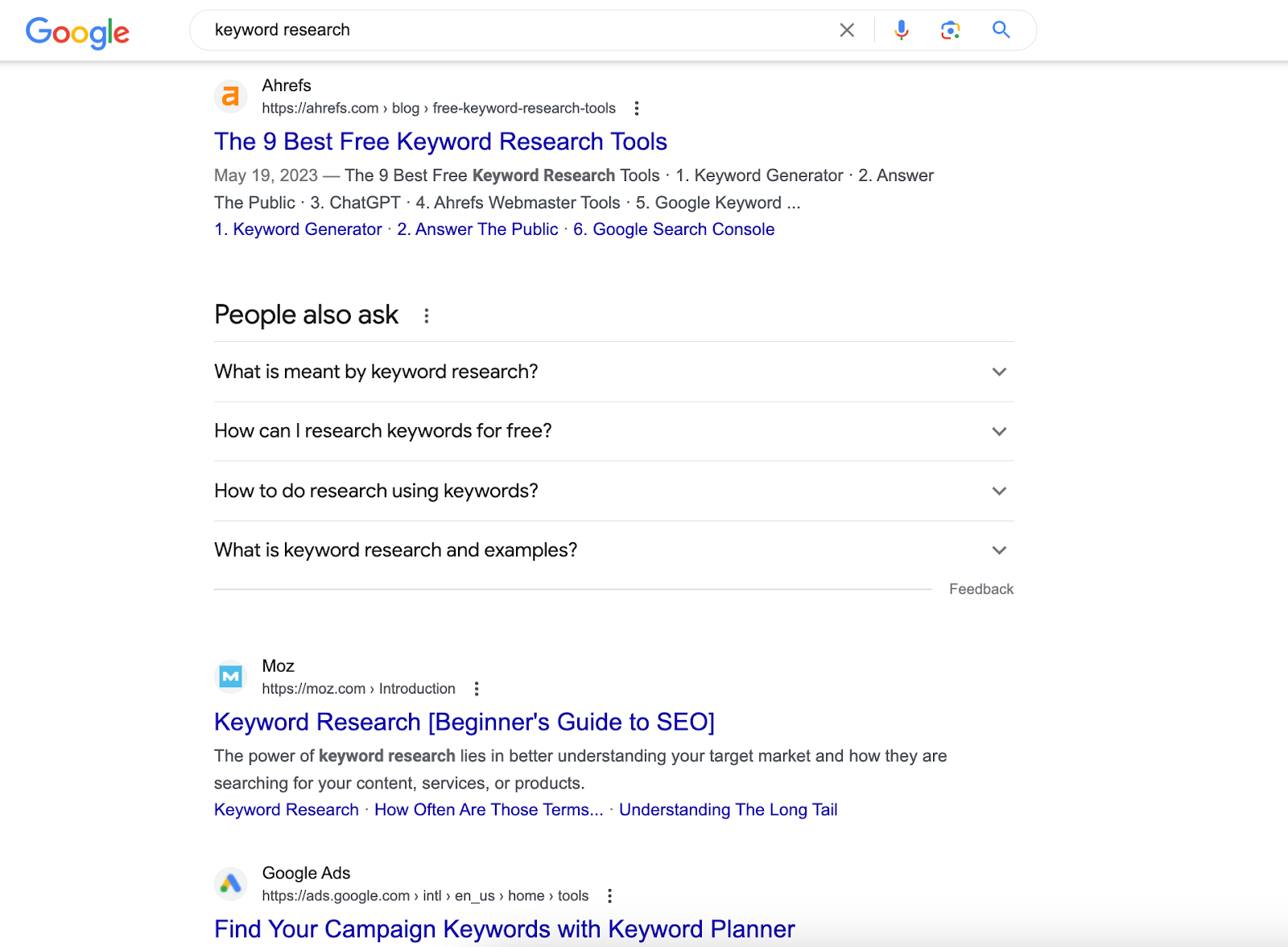SEO for Writers: A Deep Dive Into Keyword Research and Analysis
For writers—from authors to bloggers to educators—the first and most important part of any Search Engine Optimization (SEO) strategy revolves around keywords. You’ve probably read countless articles about maximizing your search presence by including keywords and adding value for your target audience. Today, we’re looking at what keywords are, how to find the right keywords for your content, and how to work those keywords into your content in natural ways.
What Are Keywords?
Keywords are the terms and phrases searchers use to learn more about a topic. As a content creator, you’ll use a variety of tools to find those keywords and use them in your own content.
Keywords can be separated into two distinct types:
- Individual Keywords
- Long Tail Keywords
An individual keyword is one or maybe two words that are very general. “Books,” “Writing,” and “Netflix” are general keywords. A long tail keyword is a specific search query, like “Where do I buy books online that aren’t Amazon?” or “How to log into my Netflix account?”
Search engines use the words you put in the search box to find content that they think will answer your question or provide the content you’re looking for. To do so, those search engines ‘scrape’ loads and loads of websites looking for relevant content. Individual keywords will provide more results with less specific information, while long-tail keywords should help searchers find very specific answers.
Let’s say I wanted to learn more about publishing a children’s book. I might go to Google and search “How do I publish my children’s book.” This search has two keywords (publish & children’s book). Including ‘How’ also clues Google in that you’re looking for information.

Based on this query, Google will look at all kinds of content across the web that involves publishing and children’s books, then show you those that it thinks will answer your question the best.
Your job as a content creator is to liberally use keywords to ensure search engines show searchers your content.
Your keywords help those search engines understand your content, who it’s for, and why it’s valuable. If you write blogs about how to publish children’s books and you’ve done a good job applying keywords to your content, Google will know what you write about.
Your Keyword Research Strategy
Ten or so years ago, optimizing content for search was all about keywords. Some sites would ‘stuff’ their pages with specific keywords, tricking search engines into sending traffic to their site without actually creating valuable content.
Today, search engines are more sophisticated and look for the best content based on what people are searching for, with far less weight given to individual keywords.
With its refined algorithms, Google looks at the intent behind a search and aligns that with (what it deems) the best topics to answer that search. That doesn’t change the fact that you’ll need to include keywords on your site, but it does mean you need to be very particular about the keywords you use and how you use them.
To simplify this complex task, I like to break it down into four parts:
- Audience understanding
- Keyword discovery
- Keyword research and analysis
- Competitor discovery
This is roughly the order you’ll do each part in as well, though you may not always need to follow this outline. Let’s break down each part of your SEO work with extra emphasis on how to do effective keyword research.

Your Free Lulu Account
Create a Lulu Account today to print and publish your book for readers all around the world
Finding and Understanding Your Audience
You’ve likely already done a fair amount of audience research. From developing personas to surveying your existing fans, you should have some good ideas about who your fans are and what they like.
When it comes to an individual piece of content (like a blog post, YouTube video, or podcast episode), you’ll benefit from going just one step further. You can’t make all of your content for all of your audience. You need to determine exactly who you’re speaking to and let that guide you as you develop your keyword list.
For example, this blog post is for content creators who are developing strategies for growing their audience. That means it won’t be applicable to everyone who reads this blog—authors with a dedicated audience and experienced content creators probably don’t need my advice here.
That specificity in your audience is crucial to the next step.
Discovering Keywords
If you’ve got a big budget, tools like AHREFs, Moz, and SEMRush have powerful plans with lots of in-depth information about popular keywords, their relative value, and how you rank compared to competitors. For most creators, you don’t need these expensive options.
The best free keyword research tool is actually Google. All the most popular SEO tools have some kind of free option, like AHREFs and their Keyword Generator. Or Answer The Public’s 3-free searches every day. Google Trends offers free information about search behavior to help you see new and emerging trends.
But the best place to start is with a search.
Take whatever base or seed keyword you want to rank for, open an incognito window in Chrome, and search for that term. The search engine results page (SERP) is a gold mine for keywords.

I scrolled past the sponsored content (and you should too) until I reached the top results and (most importantly) the ‘People also ask’ section. Much like the embedded videos and images, People Also Ask is an invaluable SERP feature that helps you understand how other people interact with the search engine.
In the screenshot above, you see three results and four questions.
Results:
- The 9 Best Free Keyword Research Tools
- Keyword Research [Beginner’s Guide to SEO]
- Find Your Campaign Keywords with Keyword Planner
Questions:
- What is meant by keyword research?
- How can I research keywords for free?
- How to do research using keywords?
- What is keyword research and examples?
The top three results highlight common tactics for attractive titles—offering a number of options, including the phrase ‘beginner’s guide’, and putting the reader in the title (find your…).
From this, we learn that people searching for terms like ‘keyword research’ are looking for educational answers, need help with the basics, and are interested in getting started for free.
And the four questions that follow are an essential guide to how you write your content. These are the questions people need answers to. To create highly valuable content, answer the questions you find in the ‘People also ask’ section.
Finally, scroll through the results and note additional titles that stand out. Pay special attention to any terms or phrases you see used often. This is a great way to find related keywords and to understand search intent—based on the results from your search terms, you’ll start to see how other creators are answering searchers’ questions.
Reading search results pages is always my first step in keyword research. And it’s a terrific way to find new keywords and related terms you might not have thought of on your own.

Create Your Book
Use Lulu's free templates to easily create and publish your book today.
Keyword Research and List Building
As you start to find some relevant keywords through search results, you’ll need to document what you discover. Here’s a simple Google Sheet you can use to sort your keywords. Feel free to make a copy and use it for your own keyword research.

I use SEMRush to do my research, but you can find similar information from some great free options:
- Moz – Get 10 keyword searches every month
- AHREFs – Get limited info about keywords
- Answer the Public – Get 3 searches every day
Here’s a rundown of how I use this sheet to gather keyword information:
- Primary/Seed Keyword – You should always start with a single word or short phrase as your ‘primary’ keyword. You’ll use this as the base for the longer list of keywords.
- Content Goal – Not all creators will do this, but it’s valuable to define the goal/purpose of your content—usually something tied to the primary keyword.
- Keyword – I always start with my primary keyword, then list any additional keywords/phrases I discover.
I like to start by brainstorming 8-10 keywords just based on the previous Google searches (remember to look at the People Also Ask section!). Then, I’ll use tools like Moz or SEMRush to expand the list until I’ve got 20+ keywords.
That will create a decent starting list you can use to research. You can find dozens of metrics by which SEO companies will judge the value of a keyword, but these 5 are the ones I find most valuable. You can set up your own metrics, but you need some measures to analyze keywords and select the right ones for your content.
- Volume – The approximate number of searches for this keyword (usually in a month).
- Difficulty – The keyword difficulty score will vary based on the tool you use, but it estimates how difficult it will be for you to rank for this keyword (lower is better here).
- Cost Per Click – We’re not talking about creating ads, but this value gives you a sense of how valuable and contested this keyword is.
- Intent – This defines (or guesses at) the intentions most users have when they search using the keyword—my template includes three:
- Transactional – The searcher wants to purchase or sell
- Informational – The searcher wants information or education
- Navigational – The searcher is looking for something beyond just the keyword
- Relevance – Here, you can gauge how relevant the keyword is to your goal and primary keyword—my template includes High, Medium, and Low.
After you’ve compiled your keyword list and looked at the associated information, the last important part of the keyword research process is to look at your competitors.
Competitor Keyword Research
Now that you have this awesome list of keywords, it’s time to start creating your content, right?
It can be, but one more step is worth your time and effort: competitor research.
Luckily, this last step is pretty easy. Just go to your Google search results page or use the SERP Analysis from Moz to see what pages are currently ranking for the keywords you’re researching. Then, read those articles.
Make notes about the words these articles use in their headings—article titles and heading text are often stuffed with valuable keywords. Do the top articles use a lot of images or feature lists? Are they ‘how-to’ or long, detailed explanations?
Look for common threads amongst the top-performing content and use that information to guide how you create your own.
Reading competitors’ content will help you refine your content strategy and is the best way to understand what your potential customers want. If another creator gets a lot of organic traffic to their content, you can look to them for the most effective keywords. You can’t copy what your competition does, but you can use their hard work to inform your content creation. Look for related topics you can expand on while using some of the same organic keywords.
Earning Higher Ranking with Your Keywords
Content creators and marketers must be very conscious of keyword stuffing. That means overusing keywords, whether a single term or long tail. The way modern search engines work will weed out content that is unhelpful.
It becomes a balancing act: you need enough targeted keywords in your content to get the attention of search engines, but you also must provide value to your readers. When you can do both, you’ll get more traffic to your site (thanks to search engines) and you’ll earn more customers because what you create genuinely delights them.
The entire point of keyword research is discovering what your audience (and potential audience) are searching for. Understanding how people use search enables you to write your blog articles, website copy, and anything else in ways that will lead to more readers.




